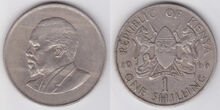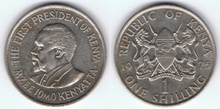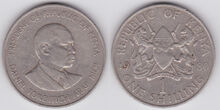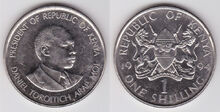- This article is about the coin of the Kenyan shilling. For the coin of the earlier East African shilling, used in British Kenya, see East African 1 shilling coin.
| Shilling | |
|---|---|

| |
| 2005 coin | |
| General information | |
| Country | |
| Value |
1.00 shillings |
| Years |
1966–2010 |
| Measurements and composition | |
| Mass |
|
| Diameter |
|
| Thickness |
|
| Composition |
|
| Appearance | |
| Shape |
round |
| Alignment |
medallic |
| Edge |
|
| Obverse |
|
| Reverse |
Coat of arms of Kenya, state title, value, year |
| v · d · e | |
The 1 shilling coin is a current circulation piece of the Republic of Kenya that was produced in five main types from 1966 to 2010. The first type was issued briefly from 1966 to 1968, during the early administration of President Jomo Kenyatta (c. 1889–1978). It was followed by a similar piece that made its appearance in 1969, and continued to be minted until Kenyatta's death in 1978. That year Daniel arap Moi (1924–) assumed leadership of Kenya, and a new 1 shilling bearing his likeness was introduced. This third type was made in two subtypes, the initial one manufactured intermittently from 1978 to 1989, and the second struck solely in 1994. Moi introduced another 1 shilling piece near the end of his presidency, in 1995, and this continued to be minted until 1998. In 2005, under President Mwai Kibaki (1931–), the most recent type made its début, which incorporated design aspects from the second and fourth types. Such a coin was last produced in 2010.
Examples of all five types continue to be circulated in Kenya, carrying valid legal tender face values equivalent to 1.00 shillings. The pieces were produced at the Royal Mint in the United Kingdom and issued by the Central Bank of Kenya (CBK).
Coins[]
Initial coins of Jomo Kenyatta (1966–1978)[]
During the existence of the British Colony and Protectorate of Kenya, a local version of the shilling was introduced as the primary medium of exchange in the territory, as well as in much of East Africa. Even after gaining independence in 1963, Kenya continued to use the colonial currency until 1966. Under Jomo Kenyatta, the first President of Kenya, the Kenyan shilling was established that year, replacing the previous shilling at par. The newly established Central Bank of Kenya (CBK) commissioned the Royal Mint at Tower Hill, London, to produce the first series of Kenyan coins, consisting of denominations of 5, 10, 25, and 50 cents, and 1 and 2 shillings. Such pieces were minted annually until 1968. The following year, in 1969, the CBK requested for the creation of a modified series of circulation coins of the same denominations. British sculptor Norman Sillman (1921–2013), who designed the initial series, was tasked with engraving the second. With the exception of the 25 cent and 2 shilling coins, which were only minted until 1973, all of the second series coins were made until Jomo Kenyatta's death in 1978.
Both versions of the 1 shilling coin are composed of a cupronickel alloy and have a mass of approximately 8 grams, a diameter of 27.8 millimeters, and a thickness of 1.65 millimeters. They bear reeded edges and have medallic alignment, and like most coins, are round in shape. The rims of both the obverse and reverse on the two types are raised and undecorated.
The obverse of both coins features a left-facing bust of Jomo Kenyatta in the center, which shows the president with his signature mustache and pointed beard, wearing a suit and tie on his upper torso. On the earlier of the two types, this illustration of Kenyatta is the only item present on the obverse. However, "THE FIRST PRESIDENT OF KENYA" is inscribed above the depiction on the second type, traveling in a clockwise direction from the left to right rims of the piece. Often considered the Father of the Nation in Kenya, Kenyatta's name was often prefixed with mzee, a local Swahili word meaning "elder". This is reflected on the 1 shilling coin, on which "MZEE JOMO KENYATTA" is printed counterclockwise from the left to right peripheries of the obverse. This text and the aforementioned legend are separated by two small, circular points. Due to the presence of this text, Kenyatta's portrait is smaller on later pieces. Aside from the dates of issue, the reverses of both types are identical. Featured in the middle of the reverse is a large rendition of the coat of arms of Kenya – which consists of a traditional East African shield divided into three fields, the one in the center bearing a rooster holding an ax. This shield is supported in the arms by two lions holding spears and standing on the silhouette of Mount Kenya, which is covered with coffee, maize, pyrethrum, sisal, pineapples, and tea, and partially concealed by a scroll bearing the Kenyan national motto "HARAMBEE", Swahili for "all put together". Printed below the arms is the numeral "1", identifying the face value of 1 shilling. The value appears again as "ONE SHILLING" along the bottom periphery of the coin, extending counterclockwise from the bottom left to right rims. The Gregorian date of minting is written horizontally in Western Arabic numerals at the middle of the coin, the first two digits separated from the last two by the arms. The remainder of the outer periphery is occupied by the clockwise text "REPUBLIC OF KENYA", which begins at the left side of the reverse and extends to the right.
A total of approximately 32,000,027 examples of the first type were produced, including 32,000,000 business strikes and about 27 proofs dated 1966. A mintage of about 104,856,515 specimens of the second coin was made, which includes 104,856,000 business strikes and 515 proofs. Of these proofs, 15 were made in 1969 and 500 in 1973.
| Mintages (1966–1968) | |
|---|---|
| Year | Mintage |
| 1966 | 20,000,000 |
| 1966 Proof | 27 |
| 1967 | 4,000,000 |
| 1968 | 8,000,000 |
| Mintages (1969–1978) | |
|---|---|
| Year | Mintage |
| 1969 | 4,000,000 |
| 1969 Proof | 15 |
| 1971 | 24,000,000 |
| 1973 | 2,480,000 |
| 1973 Proof | 500 |
| 1974 | 13,520,000 |
| 1975 | 40,856,000 |
| 1978 | 20,000,000 |
First coins of Daniel arap Moi (1978–1994)[]
Daniel Toroitich arap Moi served as the third Vice President of Kenya under Jomo Kenyatta until the latter's death. Moi then succeeded Kenyatta as president in 1978, and continued to rule the country for 24 years until largely retiring from politics in 2002. During the first year of Moi's administration, the Central Bank of Kenya commissioned the Royal Mint, relocated to Llantrisant, Wales, in 1968, to produce a new series of coins featuring the likeness of the new leader. This series contained the same denominations as the previous series, albeit excluding the discontinued 25 cent and 2 shilling pieces. Norman Sillman was again tasked with the design of the Kenyan coins. The 1 shilling coin remained unchanged for the next three years of minting – 1980, 1981, and 1989 – but in 1994 the composition was altered to a cheaper alternative. This later coin was only produced for one year.
The earlier of the two subtypes is composed of cupronickel, while its later counterpart is made of nickel-plated steel. Both coins weigh approximately 8 grams and measure 27.8 millimeters in diameter and 1.65 millimeters in thickness. Both have medallic alignment and a reeded edge, and are round in shape. The rims of the two varieties are raised and undecorated.
Displayed in the center of the obverse is an illustration of President Daniel arap Moi wearing a suit and tie and facing ½ right. The official title of Moi's position, "PRESIDENT OF REPUBLIC OF KENYA" is engraved above Moi's likeness, traveling in a clockwise direction from the upper left to upper right boundaries of the obverse. Written counterclockwise below the depiction of the president in a slightly larger font is the caption "DANIEL TOROITICH ARAP MOI". Such text commences at the lower right rim and concludes at the lower right. Moi's name and title are divided by empty spaces at the left and right sides of the obverse. Aside from the dates, the reverse is identical to that on the coins of Jomo Kenyatta. The coat of arms of Kenya appears in the middle, the state title "REPUBLIC OF KENYA" inscribed in a clockwise direction above and the value "ONE SHILLING" engraved in the opposite direction below. The numeral "1", identifying a face value of 1 shilling, is present between the arms and the word "SHILLING", and the Gregorian date of minting is included in the middle of the piece, the first two digits separated from the last two by the arms.
The total mintage of the first 1 shilling coin of Daniel arap Moi is currently unknown. Business strikes were produced during 1978, 1980, 1989, and 1994, and a handful of proofs were included in sets from 1978 and 1981. The 1981 proofs are considerably rarer than the 1978 pieces, and therefore carry a larger price tag.
Second coin of Daniel arap Moi (1995–1998)[]
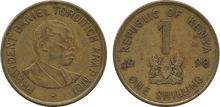
1998 coin
In 1995, during the later presidency of Daniel arap Moi, the Central Bank of Kenya authorized the production of a new series of coins, again commissioning the Royal Mint to design and produce the pieces. Such a series, consisting of denominations of 10 and 50 cents, and 1, 5, and 10 shillings, was reportedly designed by Norman Sillman. The 1 shilling piece was made during the years 1995, 1997, and 1998.
The second 1 shilling coin of Moi is composed of brass-plated steel. It is considerably smaller than previous Kenyan shillings, having a mass of 4.35 grams, a diameter of 22 millimeters, and a thickness of 1.6 millimeters. The edge of the piece alternates between reeded and plain, having four segments of each. The coin has medallic alignment and is round in shape. Both the obverse and reverse rims are raised and undecorated.
The bust of Moi that appears on the previous series of Kenyan coins is displayed in the center of the new coin's obverse. It is accompanied by the caption "PRESIDENT DANIEL TOROITICH ARAP MOI", which is written in a clockwise direction from the bottom left to right peripheries of the coin. Such text is considerably larger and more prominent than that on the earlier pieces of Moi's presidency. Although a large space below the central effigy divides the beginning and end of the aforementioned legend, a small circular point is engraved at the bottom of the piece, in the middle of the empty field. The shilling produced from 1995 to 1998 is the first of the denomination to feature a redesigned reverse. The numeral "1", identifying a face value of 1 shilling, is engraved in a large font in the center of the reverse. It is followed below by the coat of arms of Kenya, which is considerably smaller than on the earlier Kenyan shillings. The Gregorian date of minting is printed horizontally in Western Arabic numerals along the middle of the piece, and like on the coins of Kenyatta and the first pieces of Moi, the initial two digits are separated from the final two by the arms. In contrast, however, there is more space between the numbers and the arms. "REPUBLIC OF KENYA" is engraved along the upper periphery of the piece, traveling in a clockwise direction from the left to right boundaries of the reverse. The face value "ONE SHILLING" is inscribed in the opposite direction along the remainder of the coin's rim, also extending from the left to right rims.
The total mintage of the second shilling of Daniel arap Moi is currently unknown. Only business strikes are known to have been produced in 1995, 1997, and 1998.
Third coin featuring Jomo Kenyatta (2005–2010)[]
Daniel arap Moi remained President of Kenya until his retirement in 2002. Mwai Kibaki, a Kenyan politician and government office holder under both Jomo Kenyatta and Moi, was then elected as his successor that year. Kibaki would continue to hold office until 2013, when he handed power over to Uhuru Kenyatta (1961–), Jomo Kenyatta's son. During the final years of Moi's administration and first few years of Kibaki's leadership, no Kenyan coins were produced. However, in 2005 the Central Bank of Kenya called for the introduction of a new series of circulation pieces. With initial plans to issue coins in denominations of 5, 10, and 50 cents, and 1, 5, 10, and 20 shillings, only the higher five denominations were released. All of the pieces bear previous designs made by Norman Sillman. The 1 shilling piece of the series was eventually minted again in 2009 and 2010.
The shilling made under Kibaki is composed of nickel-plated steel. Weighing 5.5 grams and measuring 23.9 millimeters in diameter and 1.9 millimeters in thickness, it is slightly larger than the second type of Moi, but still smaller than the initial Moian pieces and both coins of Kenyatta. The edge of the newer piece alternates between reeded and plain, with four segments of each. The coin has medallic alignment and is round in shape. Both rims are raised and undecorated.
In spite of being struck during Kibaki's administration, Sillman's portrait of Jomo Kenyatta from the shillings issued from 1966 to 1978 appears on the obverse. Like on the second type introduced under Kenyatta, "THE FIRST PRESIDENT OF KENYA" is written clockwise along the upper periphery of the coin, and "MZEE JOMO KENYATTA" is inscribed in the opposite direction along the bottom rim, both starting and ending near the same point. Both legends are separated from each other by two small circular points. Excluding the date, the reverse is identical to that prepared for the second shilling type of Daniel arap Moi. The numeral "1", representing the coin's value of 1 shilling, appears in the center, a small Kenyan coat of arms displayed below. The Gregorian date of minting is written horizontally in Western Arabic numerals in the middle of the piece, the first two digits separated from the last two by the arms. "REPUBLIC OF KENYA", inscribed in a clockwise direction, occupies the upper periphery of the reverse, while "ONE SHILLING", engraved in the opposite direction, encompasses the bottom rim.
The total mintage of the shilling from Kibaki's presidency is currently unknown. Business strikes were exclusively produced in 2005, 2009, and 2010.
References[]
- Numismatic Guaranty Corporation website
- Numista (English) (French)
- World of Coins – Designer: Norman Sillman
- Central Bank of Kenya – Coins in circulation
- World Numismatic Dimensions – Coins of Kenya
Kenyan shilling on the English Wikipedia
Template:Kenyan shilling

